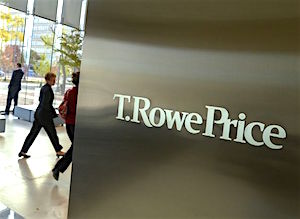
T. Rowe Price, one of the “big three” target date fund (TDF) providers, has introduced a payout vehicle that aims to deliver a non-guaranteed, 5% per year income stream to retirees from retirement plans that the Baltimore-based financial services firm administers.
The new product is the “Retirement 2020 Trust–Income,” a collective investment trust (CIT) that resembles T. Rowe Price’s Retirement 2020 TDF, but with an income feature for retirees.
“We had a plan sponsor come to us looking for a way to take a participant’s savings balance and create an income process,” said Michael Oler, vice president and Retirement Income Product Manager at T. Rowe Price. “They wanted to provide a solution that was liquid, that was easy to communicate to participants, and simple to monitor. The payout strategy checked a number of those boxes.”
T. Rowe Price did not disclose the name of the plan sponsor who requested the service. Generally speaking, a managed payout fund could be attractive for a defined contribution plan sponsor that has discontinued its defined benefit plan and whose employees are accustomed to having an income solution at retirement.

Oler
The money in the trust would still remain in the defined contribution plan. Some plan sponsors are said to want to keep large 401(k) accounts in the plan because they help maintain the size of the plan and the economies of scale that help keep overall plan costs down. Conserving small-balance clients would be counterproductive, given that they can cost more to maintain than they earn.
The Retirement 2020 Trust – Income was set up as a CIT because the client that requested it was a trust investor, a T. Rowe Price spokesperson said. But it will have the same “glide path,” or asset allocation that becomes more conservative over an investor’s lifetime, as its mutual fund twin. That glide path starts at about 90% stocks, starts falling 25 years prior to retirement and reaches about 55% stocks at the retirement date (presumably age 65). The stock allocation levels off at 20% of the portfolio 30 years after retirement.
The payout version of Retirement 2020, either as a CIT or a mutual fund, won’t be available to active participants in T. Rowe Price-administered retirement plans, only to former plan participants who have separated from service and are over age 59½ (the date from which there’s no federal tax penalty for withdrawals from qualified retirement accounts).
“We start communicating the availability of the payout option at age 55. It’s available to them but they can’t vest in it until they’re terminated. This gives them a few years to use the income calculator to determine how much income their savings can generate. Then we’ll have communications that go out to people who have been terminated and over 59 ½ reminding them of the service. Our call center staff will be trained on the product,” Oler said.
Through a web portal, T. Rowe Price will provide “an overview of the strategy, along with modeling capabilities to show how much monthly income could be generated by transferring a certain amount into the strategy, or conversely, how much they would need to transfer to receive a certain amount of monthly income. Product information will also be added to termination kits to remind participants about the availability of the strategy.”
Every September 30, the managers of the Retirement 2020 Trust will calculate the following year’s payout based on the trust’s average monthly net asset value over the previous 60 months. The 5% will be paid out in 12 monthly installments by direct deposit or check. If the recipients are over age 70½, the distributions will count toward their required minimum distributions. This distinguishes the product from a systematic withdrawal plan of a certain amount or certain percentage from a 401(k) account.
“It’s important to point out that Retirement 2020’s managed payout program is not a 5% withdrawal annually; rather, it pays 5% of the rolling 60-month NAV (net asset value),” T. Rowe Price said. “The significant difference is that the participant maintains the same number of shares as distributions are paid, where a withdrawal is the continuously reducing number of shares that will eventually deplete.”
As for the expense ratio, “Pricing for the Retirement Trusts vary depending on multiple factors, including, but not limited to, a plan’s eligibility to invest in the Retirement Trusts as well as total assets invested. Our pricing for plans eligible to invest in the Retirement Trusts begins at 46 basis points and decreases as a plan’s invested assets increase,” a T. Rowe Price spokesman told RIJ. There is no additional fee for the managed payout feature.
The investment is entirely liquid. Investors can buy or sell additional units in the trust at any time. According to the prospectus for the mutual fund TDF for 2020, “At the target date, the fund’s allocation to stocks is anticipated to be approximately 55% of its assets. The fund’s overall exposure to stocks will continue to decline until approximately 30 years after its target date, when its allocation to stocks will remain fixed at approximately 20% of its assets and the remainder will be invested in bonds.”
“It has the same glide path and the same fees as our other TDFs. Just as there are five-year vintages in the TDF, we expect to have five-year vintages in the managed payout funds,” Oler told RIJ.
“About 40% of the assets in our TDFs are in shorter-dated vintages, up to 2030, if you translate that to the overall TDF market, it’s about $1.8 trillion,” said Joe Martel, a T. Rowe Price target date fund portfolio specialist. “In terms of assets, that’s a meaningful market. The retirees who retire in the next 10 years are people who will have spent more years in defined contribution plans than current retirees. They’re used to the defined contribution model and to TDF investments.”
Vanguard introduced a managed payout mutual fund-of-funds about 10 years ago, and continues to offer such a fund. Its target payout is 4% per year. It has an expense ratio of 32 basis points per year (0.32%) and has an asset allocation of 53% stocks (including 24% Vanguard international stock index), 22.5% fixed income and 24% alternatives (including about 7% commodities). With a 4% payout, the fund runs a low risk of running to zero before the client dies (assuming a 30-year retirement).
Fidelity’s managed payout fund for people retiring in 2020 has evolved into a Fidelity Simplicity RMD 2020 Fund. It’s intended to be used in conjunction with the firm’s systematic withdrawal plan. The two can work together to ensure that clients distribute enough money from retirement accounts each year to fulfill their required minimum distributions. The expense ratio for that fund is 61 basis points (0.61%) per year.
These funds are useful in providing non-guaranteed income for retirees who are not “constrained;” that is, retirees who have adequate savings to last for a lifetime and who can afford to draw down an income from a liquid account that fluctuates with the market.
Retirees who need to squeeze the maximum income from a designated portion of their savings might be better off pooling their longevity risk with others in order to get a higher income yield.
For instance, a $300,000 purchase premium for an immediate annuity for a 70-year-old man would yield an income of $1,892 per month for life (with 10 years certain) or $1,747 per month for life (with cash refund). By contrast, the Vanguard fund would pay out about $1,000 per month and the T. Rowe Price Retirement 2020 Trust would pay out about $1,250. So keeping $300,000 liquid would cost a 70-year-old man at least $500 a month in income, or $60,000 over 10 years.
© 2019 RIJ Publishing LLC. All rights reserved.

